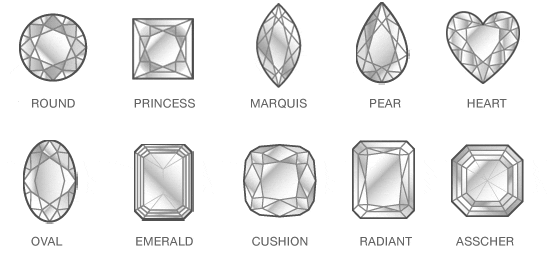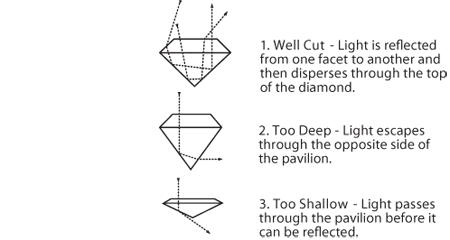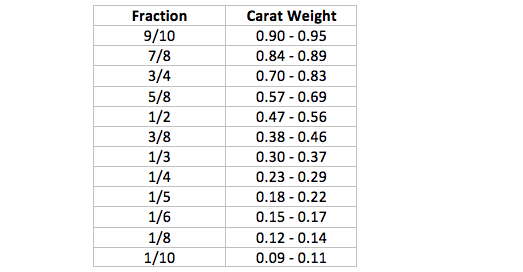Official guide to buying and maintaining diamonds
The 4Cs of
diamonds
Cut, Carat,
Color and
Clarity – are the
universal language of
the diamond. Understanding this
language will help you understand
your diamond.
Cut
The term “cut” has two references: One is the diamond’s shape, the other is the quality, determined by its proportions, symmetry and polish.
The top-selling diamond cut shape is the round brilliant. Other cut shapes including princess, marquise, pear, heart, oval, emerald, radiant, cushion and Asscher are considered fancy cut.

The cut of a diamond is considered to be the most important factor with respect to its beauty. The cut determines the brilliance of the diamonds – how light is reflected , dispersed and scintillated. Unlike color and clarity, there is not a single grade that defines it. Furthermore, two diamonds equal in carat weight, color and clarity can differ in appearance and value because of differences in cut quality.
The cut is the most complicated of the 4Cs. Unlike carat weight, color and clarity, whose value and rarity are related to the diamond’s natural formation, cut quality is the result of human decision and diamond cutting skills.

There are three factors that determine a diamond’s cut quality:
- Proportions: the relative sizes and angles of the diamond’s parts and facets
- Symmetry: the precision of the cut design, especially the facets
- Polish: the smoothness and luster of the diamond’s surface

The cut grades are referenced on a diamond’s certificate often using the GIA standards of Excellent, Very Good, Good, Fair and Poor. For the most part, the actual measurements are mainly on the laboratory reports.
The quality of a diamond’s cut always speaks for itself.
Carat
Carat weight is the easiest to understand of the 4Cs. A diamond’s weight is measured in carats. The carat is subdivided into 100 equal parts called ‘points.’ One point equals .01 carat or 1/100 carat. A one carat diamond equals 100 points. Carat weight is written in decimal numbers, but it is frequently expressed in fractions which are easier to understand. Diamond weight fractions are approximate and refer to ranges of weight. This chart from The Diamond Council of America® is a handy reference:


Diamond prices increase with carat weight because larger diamonds are less common and more desirable. However, two diamonds of equal carat weight can have dramatically different values depending on three other factors: Color, Clarity and Cut. In jewelry pieces with more than one diamond, the carats are described in terms of total carat weight (T.W.). This is the combined total weight of all the diamonds in the piece. Determining the carat weight that is right for you depends primarily on your budget and taste.
Color
Choosing the right color for your diamond is based on personal preference. It’s important to remember that you are generally searching for a stone with little to no color.
Diamonds are colored when the crystals grow inside the earth. Tiny traces of some elements like nitrogen can color the crystals. In addition, the pressure involved in the diamond formation creates distortion in the crystal structure which is believed to also contribute to its color.
The color evaluation on gem-quality diamonds is based on the absence of color. The Gemological Institute of America (GIA) uses a 12-letter alphabetical scale of D to Z. Using this scale, the diamond on the lower end of the scale (D) will have the least amount of color – it is considered a colorless stone. The diamond at the higher end of the scale (Z) has deeper tones. However, when a diamond’s color is more intense than the “Z” grading, it enters the realm of a “Fancy Color” diamond. In this case, the intensity of the color in the diamond can play a significant role in its value. The value of a Fancy Colored Diamond can surpass that of colorless diamonds if the intensity of the color is high and the color is rare.

- D grade is absolutely colorless
- E and F are essentially colorless. The difference between D, E, and F is so slight that only experts can see it when the diamonds are unmounted.
- K, L, and M are faintly tinted. Diamonds under 1/2 carat appear colorless when mounted. Diamonds over 1/2 carat may show a tint of color.
-
Grades N through Z have a light
tint, and it is
visible.
Diamonds with less color are more rare and valuable. Only about 5,000 of the polished diamonds produced each year weighing 1/2 carat or more are colorless. Most of the diamonds sold are grades G to L. For fancy diamonds, the value goes up with the intensity of the color.
Fancy colors include bright yellow, pink, champagne, blue and green. Red, purple and orange diamonds, though found in nature, are extremely rare.
How the diamond is set can make a difference in color too. Color is more important in rings than earrings and pendants because the diamond is usually larger.
- Putting a truly colorless diamond in a yellow gold setting will reflect on the stone causing a yellowish tint.
- Colorless and near-colorless diamonds come alive in a platinum or white gold setting.
- A slightly yellow-tinted diamond will appear whiter in a yellow gold setting. Keep in mind that color is only one of the 4Cs so even when a stone has a visible tint, it can still be very lovely when mixed with good clarity and cut.
Clarity
Simply stated, clarity is a measure of the tiny imperfections found in most every diamond.
A flawless diamond with little to no imperfections is often desired due to its rarity, but they are also the most costly. Therefore, it is important to keep in mind that it is very common for diamonds to be formed with slight imperfections.
These imperfections are known as “inclusions” and usually occur during the diamond’s crystallization period within the earth, or from the stresses of mining and processing. Inclusions are anything from tiny white points to dark dots, cracks or scratches. The fewer inclusions, the more valuable a stone is. Clarity is evaluated using a 10-power magnification. This means that the object viewed appears 10 times its actual size. The diamond grader examines the clarity characteristics with respect to the nature and number of characteristics, as well as their size, color and position. The clarity grade assigned reflects the degree of visibility of the characteristics.
The GIA Diamond Clarity Grade scale has five main categories of clarity characteristics with 11 grades in all.

The FL Grade
(Flawless)
The
term FL or flawless is
used for diamonds in which a
qualified observer, under
favorable lighting conditions,
cannot find internal
characteristics and/or faults by
thorough examination with a 10X
loupe.
The IF Grade (Internally
Flawless)
A
diamond which has no
internal characteristics but
which, due to minor finish
faults,
is not flawless and therefore
cannot be designated FL or
flawless, may be called IF or
internally flawless provided the
finish faults are so minute that
they can be removed by a gentle
polishing with only an
insignificant loss of weight.
The VVS Grades (Very,
Very
Small
Inclusions)
The
term VVS is used for
diamonds with internal
characteristics very, very
difficult for a qualified
observer
to find under observation
conditions as described.
Further,
there may only be insignificant
finish faults.
The VS Grades (Very
Small
Inclusions)
The
term VS is used for
diamonds in which it is
difficult
for a qualified observer, under
observation conditions as
described, to find either a few
somewhat larger internal
characteristics or several very
small ones.
The SI Grades (Small
Inclusions)
The
term SI is used for
diamonds in which a qualified
observer may, without
difficulty,
under observation conditions as
described, find internal
characteristics. Further, there
may only occur single finish
faults of an insignificant kind.
The I Grades
(Imperfect)
The
term I or imperfect is
used for diamonds in which a
qualified observer, with the
naked
eye, can see internal
characteristics and/or in which
such major faults occur, which
substantially reduce the value
of
the stone. Only about
2% of the world’s diamonds are actually flawless. Most retail stores carry VVS as their highest grade. VS or SI are considered by most to be “fine quality” diamonds.
Types of Diamond flaws
Diamonds often possess unique markings – either internal (known as inclusions) or external (known as blemishes). A diamond’s clarity grade depends on the absence or abundance of such inclusions and blemishes.
The following lists some commonly used terminology to describe a diamond’s internal and external characteristics:
External Flaws
- Natural – unpolished surface, the original ‘skin’ of rough diamond
- Pit – small indentation on a flat surface
- Cavity – opening on surface
- Nick – minor surface chip
- Grain/twinning line – irregularity in crystal growth
- Scratch – small groove (can be due to normal wear)
- Chip – broken along external edge
Internal Flaws
- Cleavage or feather – inclusion along atomic grain
- Fracture – irregular shaped break
- Included – inclusions within diamond
- Carbon spot – included crystal
- Pinpoint – small included crystal (appears white)
- Cloud – group of pinpoints
- Internal grain line – visible part of internal grain structure
- Laser drill hole – clarity enhancements to remove/reduce appearance of inclusions
- Bearded or feathered girdle – minute to small hairline fracture extending from girdle into stone
The clarity grade of a diamond not only affects the value and price, but can also be a good indication of the diamond’s vulnerability. Heavily included diamonds can be prone to breakage.
We like to believe there is actually a fifth C: Care
Caring for your diamond jewelry keeps the diamonds looking their best and prevents them from being lost or damaged.
A regular, professional cleaning is recommended, usually every six months. Diamond jewelry can easily acquire a buildup of dirt, make-up and other materials that can diminish brightness, especially if it is worn every day. Every Zales store offers professional cleanings free of charge. Our Jewelry Consultants will also check for loose diamonds, bent or broken prongs or loose settings. Regular professional cleaning and inspections will also ensure your diamond warranty remains in effect.
At-Home Diamond Care
If you wear your diamond jewelry every day, you should clean it once a week. Ultrasonic cleaners are convenient and effective. However, you should avoid using an ultrasonic cleaner if your diamond has a serious crack or inclusion. The vibrations of these cleaners may enlarge such flaws.
If you choose not to use an ultrasonic cleaner, clean your diamond jewelry with a soft-bristled toothbrush and a clean liquid detergent. Rinse with fresh water and dry polish with a chamois or microfiber cloth.
Keep your diamonds looking new by following Diamond Do’s and Don’ts:
- DO store your diamond jewelry separately in your jewelry box. Since diamonds scratch other diamonds, and can also scratch pearls and other gemstones, the optimum way to store diamonds is alone or in a soft pouch.
- DON’T wear your diamond jewelry while doing activities like household chores, gardening or sports. If you do, make sure your jeweler checks your item for loose or broken prongs regularly.
- DO take your ring in for inspection and professional cleaning at least twice a year.
- DON’T wear your diamond jewelry while applying lotions, makeup, hair sprays or perfumes. These chemicals can dull the sparkle of your diamond jewelry.
- DO insure your diamonds against loss or theft. A diamond engagement ring is an investment of both money and emotion. Your insurance company can provide a rider to cover any costly items such as an engagement ring or other diamond jewelry.
Courtesy of:
